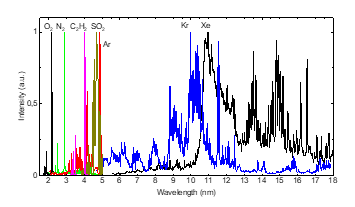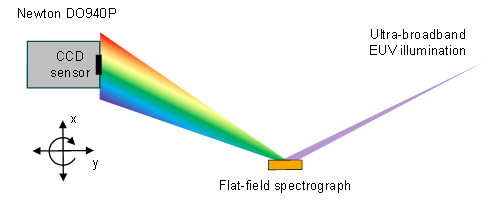Resources
 Part of the Oxford Instruments Group
Part of the Oxford Instruments Group
Expand
Collapse
 Part of the Oxford Instruments Group
Part of the Oxford Instruments Group
The research group EUV Technology at RWTH Aachen University, TOS - Chair for Technology of Optical Systems (RWTH-TOS), works on compact stand-alone setups that utilize extreme ultraviolet (EUV) radiation for nanometrology and nanostructuring purposes. EUV radiation offers unique properties for these applications including a short wavelength of the order of 10 nanometers as well as a strong and element-sensitive interaction with materials of all kinds. Compared to the utilization of ultraviolet and visible light, the properties of EUV radiation enable significant progress in the fields of nanoscience and semiconductor technology.
A stand-alone EUV spectrometer was built at RWTH-TOS which measures ultra-broadband spectrometric characterizations of samples in the EUV spectral range [1-5]. Typical samples are ultrathin layer systems down to sub-nm thickness, nanostructured surfaces as well as novel material compositions related to semiconductor technology.
The spectrometer measures reflectance as well as transmittance in the wavelength range from approximately 2 nm to 18 nm. It is based on the emission of a gas discharge-produced plasma source emitting broadband spectra in the EUV spectral range. The spectral range is approximately between wavelengths of 2 nm to 20 nm depending on the fuel gas(es) utilized in the source (see Fig. 1) [6].
 Fig. 1 Emission spectra of a discharge-produced plasma operated with different fuel gases ranging approximately from 2nm to 18nm wavelength [6].
Fig. 1 Emission spectra of a discharge-produced plasma operated with different fuel gases ranging approximately from 2nm to 18nm wavelength [6].
In order to capture a wide wavelength range of the EUV spectra emitted by the plasma source, the EUV-sensitive Newton SO CCD camera model DO940P-BN from Andor Technology with a rectangular wide format back-illuminated CCD sensor (2048 x 512 x 13.5 µm pixels 27.6 mm x 6,9 mm) is integrated into the stand-alone EUV spectrometer. Despite the comparably large size of the CCD sensor, it is still not capturing the full spectral dispersion produced by the utilized flat-field spectrograph (see Fig. 2). For this, the camera needs to be translated along the dispersion axis (x-axis). In order to guarantee the optimum focus distance and angular orientation with respect to the spectrograph, a translation along the beam axis (y-axis) as well as a rotation in the x-y plane is necessary.
 Fig. 2 Schematic depiction illustrating the necessity to move the CCD sensor along the dispersion direction of the flat-field spectrograph.
Fig. 2 Schematic depiction illustrating the necessity to move the CCD sensor along the dispersion direction of the flat-field spectrograph.
Since EUV radiation cannot propagate under ambient pressure conditions, experimental investigations involving EUV radiation need to be conducted under vacuum conditions. Conducting the above-mentioned movements therefore poses a significant challenge regarding the hardware implementation. To meet this challenge, the CCD camera is mounted in a hanging position to a highly robust positioning module consisting of a cross-translational stage enabling travel of several centimeters in both orthogonal directions and a rotational stage between the cross-translational stage and the CCD camera. The positioning module including the camera is connected to the main vacuum setup by a flexible vacuum bellow. The positioning module can withstand forces created by the vacuum pulling on it as well as the weight of the vacuum components hanging on the stage (see Fig. 3). [7]
-antoine-varagnat-20210810100815.png) Fig. 3 Newton DO940P-BN CCD camera mounted on a highly robust translational stage connected to a vacuum chamber by a flexible edge-welded bellow.
Fig. 3 Newton DO940P-BN CCD camera mounted on a highly robust translational stage connected to a vacuum chamber by a flexible edge-welded bellow.
In summary, the CCD camera mounted on the presented positioning module enables ultra-broadband spectrometry in the EUV. The setup ensures an accurate alignment of the camera with respect to the dispersion and focusing properties of a flat-field spectrograph while maintaining vacuum conditions. The setup has overall demonstrated an excellent robustness and usability [4,5].
Lukas Bahrenberg, M. Sc.
Chair for Technology of Optical Systems (TOS)
RWTH Aachen University
Steinbachstraße 15
52074 Aachen
Germany
Phone: +49 (241) 8906-8326
E-mail: lukas.bahrenberg@tos.rwth-aachen.de
Web: https://www.tos.rwth-aachen.de
Date: December 2020
Author: L. Bahrenberg, S. Schröder, S. Brose, Chair for Technology of Optical Systems (TOS)
Category: Application Note
